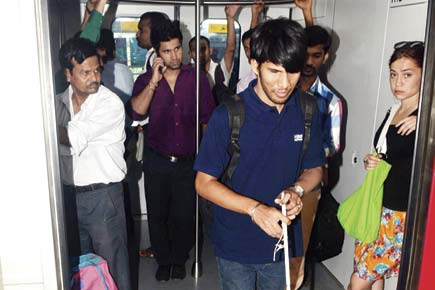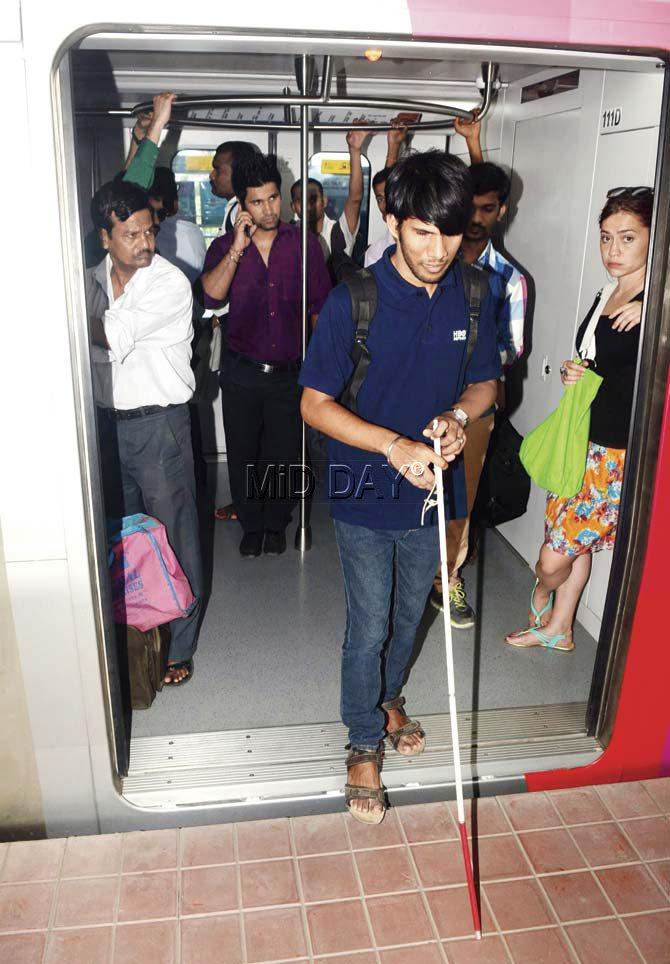Prathamesh Bendre, visually-challenged person tries the four arms of our transport system, to find out the rough and smooth of Mumbai commuting

As a visually-challenged person, life has thrown me bigger challenges than it has, sighted persons. I am a Dombivli resident and I study at St Xavier’s College in SoBo. I commute to college by local train so my experience with buses is limited.
ADVERTISEMENT

Prathamesh Bendre commuting by Metro from Ghatkopar to Versova. Pic/Sayed Sameer Abedi
Yet, it is not that I do not commute by BEST bus too. I do travel by BEST buses on various occasions. I took the BEST bus when I used to go to Victoria Memorial School for the blind at Tardeo on an assignment. I used to take the bus from Byculla to Tardeo. I also travelled by BEST bus from Dadar to Worli Seaface for a few days.
Buses
There are some difficulties the visually-challenged like me face, while travelling by BEST bus. First of all, locating a bus stop is troublesome. After that, to read the board at the bus stop with bus numbers is impossible, so we have to ask passersby or those waiting at the stop the numbers of the buses stopping here.
Once a visually-challenged commuter finds the right bus stop where the bus that he wants stops; the next challenge is to know which bus has come to the bus stop. If there are no people around, then there is no one to ask. That is the most difficult situation for the blind.
For a non-regular bus traveller like me, once I am in the bus; I have to keep asking the bus driver or conductor, where we have reached. My experience of traveling in BEST buses is not very memorable. Railway stations have beepers near the reserved compartments for persons with disability; there are announcements at every railway station. But, in case of bus travel, there is not much accessibility for handicapped people.
From the accessibility point of view; there is urgent need for change to address four basic problems:
1. How can a visually-challenged person easily locate the bus stop?
2. How can he or she find out the bus numbers of the buses that stop at a particular stop?
3. How can a visually challenged person know the bus number of the bus that has arrived at a particular stop?
4. Once he or she manages to get in, how does he know the destination?
Trains
The Mumbai local, often referred to as the city’s lifeline is an integral part of my daily life too. Except for Sundays, there is hardly any day in the week when I don’t travel by local train. I have been travelling alone in local trains for the last five years. I stay at Dombivli and my college is at Mumbai CST.
So I do daily up-down travel. Besides that, going out with family and friends for various programs over the weekend also includes train commute. When you are visually-challenged, travelling alone in the local trains is not easy. Getting into the reserved compartment is made easier by the installed beepers near the compartments.
But there are various other issues besides just boarding the train. I have fallen thrice on the railway tracks. Many times during peak-hours I am forced to miss many trains because the reserved compartments are overflowing with non-handicapped commuters. On April 22, the railway authorities positioned Samvedna teams at crowded railway stations like Dadar, Kurla, Ghatkopar and Dombivli.
These were special teams with 8 to 10 members, both male and female, to check if the people getting in the reserved compartments are handicapped commuters or not. The checking happened strictly for the first few days. But the condition in the reserved compartments has not improved.
Able passengers stopped travelling in the reserved compartments for a day or two, but now that there are no regular checks, the reserved compartments are again full with non-handicapped passengers. Most of the Harbour Line stations have tactile floorings near the edge of the platform which helps visually challenged commuters to know where the platform ends.
Such tactile flooring can prevent visually challenged commuters from falling on the railway tracks. The railway authorities can take a holistic approach to accommodate People with Disability (PwDs) in its services by working on improving the infrastructure and long-term vigilant checking. People tend to push and dash against handicapped commuters when in a hurry, it is important for sighted people to walk with caution.
Metro
A 45-minute-long journey, from Ghatkopar to Versova on the Mumbai Metro, was very eventful as I was checking the accessibility for the visually-challenged. The lift service that leads to the metro station has Braille labels on the switches indicating different things. For example, the letter (P) indicates platform. On the platforms, there are tactile markings.
These are yellow raised lines some distance away from the tracks for the visually challenged commuters to walk confidently on to the platform. Plus when there are turns going towards the lift or towards the staircase, the tactile marking also give a tangible turn. I was told at Ghatkopar station that there are assistants to assist handicapped passengers at the platform, but there were no assistants to be found.
I spoke to a senior Mumbai Metro One Pvt Ltd (MMOPL) official; he said the assistance will be provided once the handicapped passenger contacts the customer care counter. And the customer care contacts the staff at the station where the handicapped passenger is getting down so that an assistant can be there when the passenger gets down.
I contacted the Versova customer care officials and received an assistant to board the train. I also informed him that I would be getting down at Ghatkopar station and would require assistance. But after getting down at Ghatkopar, there was no assistant to be found. In the compartments, there are reserved seats for the handicapped and senior citizens.
But during the rush hours, reserved seats were found to be occupied by other passengers, resulting in me standing. Like in local trains, the next station too is announced in the metro. They also announce on which side the door opens which is useful for visually-challenged commuters. For the hearing impaired passengers, the light on the name of the coming station blinks, which indicates to the hearing impaired person even if he or she can’t listen to the announcement.
There are also separate gates at the stations for the handicapped passengers which remain open for a longer duration. Normally, a gate remains open for 30 seconds. But the special gates wider than the regular gates remain open for a minute, giving enough time for the handicapped persons to pass through.
Monorail
I travelled in the Mumbai Monorail which is a short distance travel experience with just seven stations on the way between Wadala depot and Chembur. Currently, the monorail stations have lift services but there are no Braille labels to help visually-challenged commuters. However, there are tactile markings on the platforms similar to the metro stations. The monorail has no reserved seats for PwDs.
In the monorail, the side on which the doors open is also not announced. When asked about this, the monorail official at Wadala depot said, “Since the project is currently running in its first phase, there is not much crowd. People give place to sit to the handicapped. Therefore, there are no reserved seats. But as and when the monorail starts running in its full form, we will come up with more facilities for the disabled.”
About the side of the door opening not being announced he said, “On all mono stations the doors open only on one side, which is why we did not find it important to be announced. Handicapped passengers are aware of it generally. But if more PwDs request, we can surely work on it to provide better service to our passengers.”
The monorail official said, “We have not officially announced any assistance to handicapped passengers. Our guards are always happy to help handicapped commuters to board the train.” In the absence of any official assistance, my mono travel from Chembur to Wadala depot went smoothly and comfortably because of the helpful nature of Mumbaikars.
Prathamesh Bendre is a 20-year-old blind student, residing at Dombivli
Highlights
>> Bus commute difficulties include seeing numbers on buses and stops.
>> Train bane is the number of able or non-handicapped passengers that sit in the handicapped compartment making it crowded for Persons with Disabilities (PwDs).
>> The Metro provides a good experience for the blind but assistance must be more accessible.
>> People were very helpful during the monorail journey.
 Subscribe today by clicking the link and stay updated with the latest news!" Click here!
Subscribe today by clicking the link and stay updated with the latest news!" Click here!






